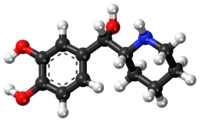Rimiterol
Chemical compound
Pharmaceutical compound
 | |
 | |
| Clinical data | |
|---|---|
| Pregnancy category |
|
| ATC code | |
| Legal status | |
| Legal status |
|
| Identifiers | |
| |
| CAS Number | |
| PubChem CID | |
| ChemSpider |
|
| UNII | |
| ChEMBL | |
| CompTox Dashboard (EPA) | |
| ECHA InfoCard | 100.046.627 |
| Chemical and physical data | |
| Formula | C12H17NO3 |
| Molar mass | 223.272 g·mol−1 |
| 3D model (JSmol) | |
| |
| |
| | |
Rimiterol (INN/USAN) is a third-generation[1] short-acting[2][3] β2 agonist.
See also
[edit]References
[edit]- ^ Palma-Carlos AG, Palma-Carlos GS (April 1986). "Beta-2-agonists of third generation". Allergie et Immunologie. 18 (4): 31–2, 35. PMID 2899434.
- ^ Lai CK, Twentyman OP, Holgate ST (October 1989). "The effect of an increase in inhaled allergen dose after rimiterol hydrobromide on the occurrence and magnitude of the late asthmatic response and the associated change in nonspecific bronchial responsiveness". The American Review of Respiratory Disease. 140 (4): 917–23. doi:10.1164/ajrccm/140.4.917. PMID 2572192.
- ^ Ydreborg SO, Svedmyr N, Thiringer G (April 1977). "Comparison of rimiterol and terbutaline, given by aerosol, in a long-term study". Scandinavian Journal of Respiratory Diseases. 58 (2): 117–24. PMID 16339.
| α1 |
| ||||
|---|---|---|---|---|---|
| α2 |
| ||||
| β |
| ||||
| Phenethylamines |
| ||||||
|---|---|---|---|---|---|---|---|
| Amphetamines |
| ||||||
| Phentermines |
| ||||||
| Cathinones |
| ||||||
| Phenylisobutylamines | |||||||
| Catecholamines (and close relatives) |
| ||||||
| Cyclized phenethylamines |
| ||||||
| Miscellaneous | |||||||
This drug article relating to the respiratory system is a stub. You can help Wikipedia by expanding it. |


 French
French Deutsch
Deutsch